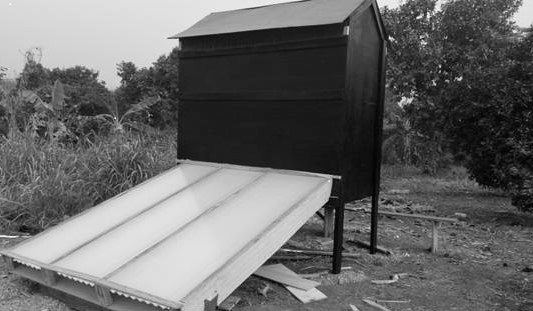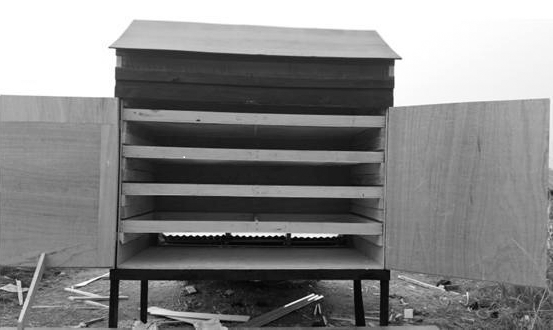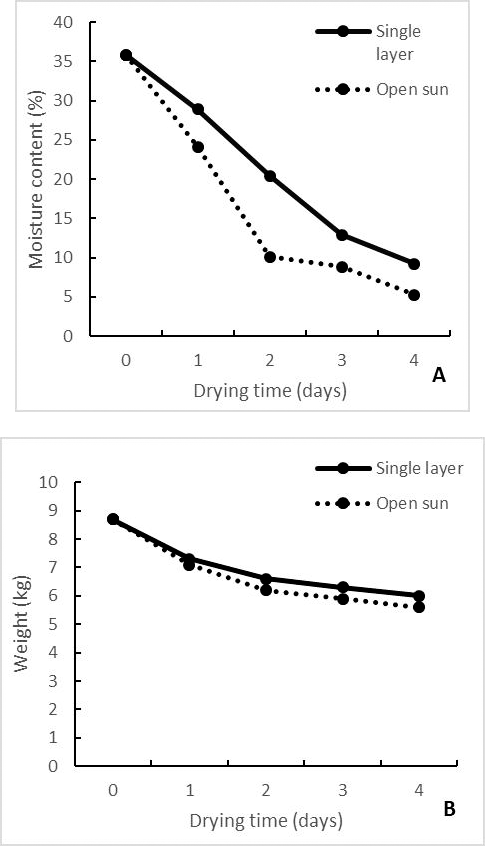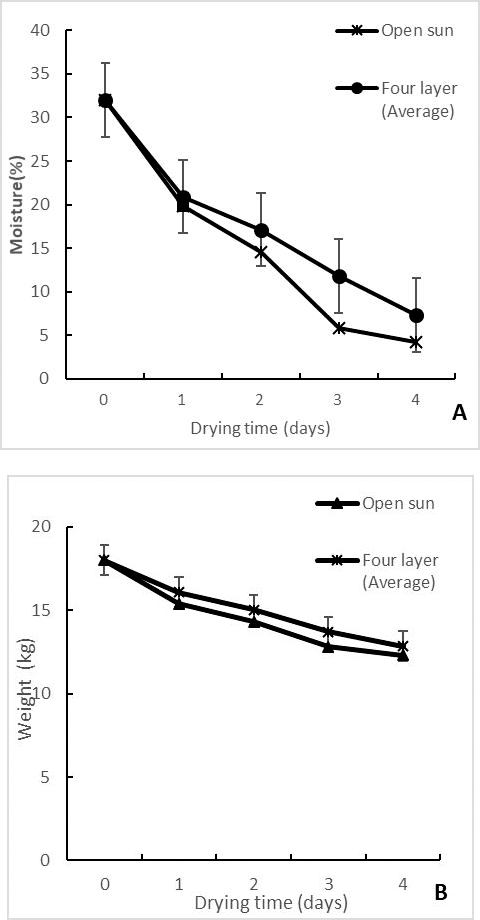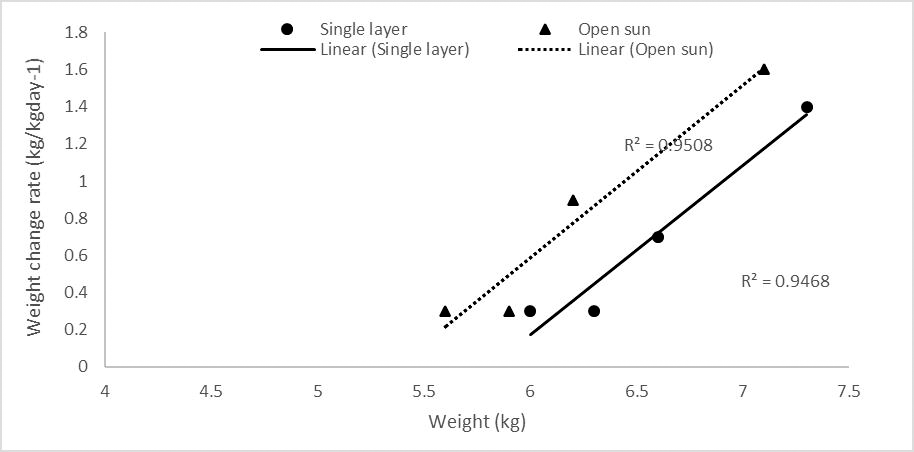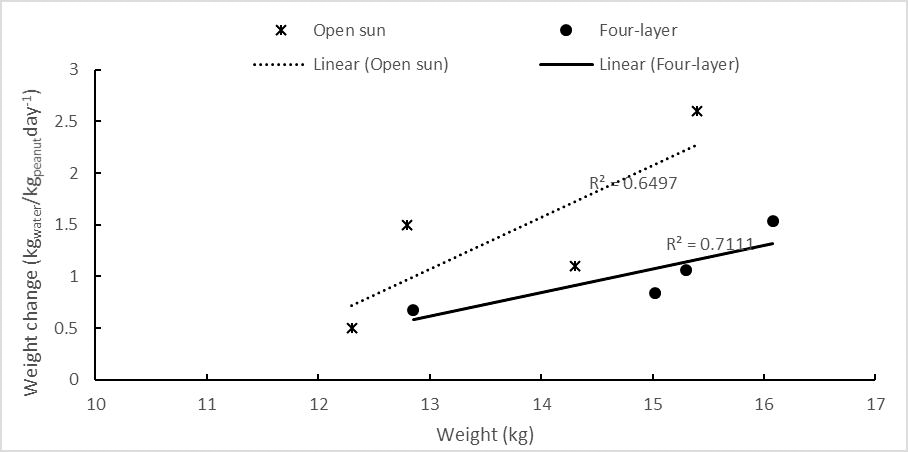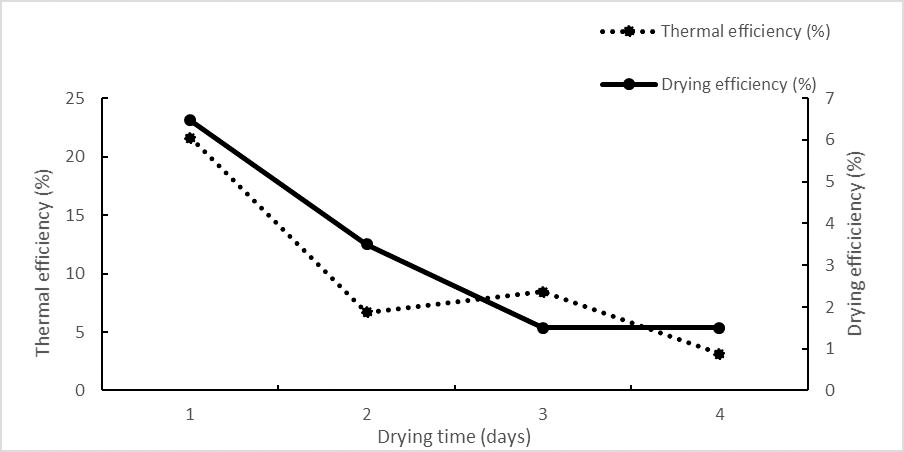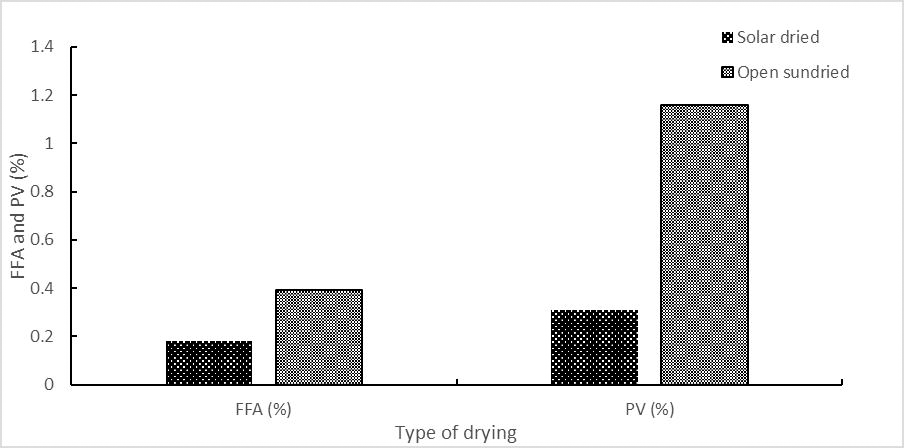Introduction
Open sun drying is the most common and oldest method of extending the shelf life of agricultural products such as cereals, nuts, vegetables, and spices by local farmers in developing countries (El-Sebaii and Shalaby, 2012). It is inexpensive and easy to adopt because practitioners simply spread the commodity to be dried on a flat surface. The drying may take place on a sheet of metal roofing, a tarp, or directly on the ground. However, open sun drying has many drawbacks including product contamination (by dirt, dust, insects, rodents and toxigenic microorganisms including Aspergillus flavus) and uneven moisture distribution in the end product (Pangavhane et al., 2002; Tsigbey et al., 2003). Furthermore, it adversely affects product quality and quantity which consequentially impacts the economic value of the products (Sharma et al., 2009). Other forms of drying require the use of electrical energy which is not available in developing countries due to limited power generation and affordability (Murthy, 2009).
Solar drying is also an old, but re-emerging technology which is economical and affordable and may avoid some of the problems associated with open sun drying (Sharma et al., 2009). Although the technology has been exploited in drying agricultural products such as maize, spices (Condori et al., 2001), and root tubers (Seidu et al., 2012), limited research has addressed its application on peanuts, a commodity of high economic and nutritional importance in most developing countries. Freshly harvested peanuts have moisture contents between 35 and 50%, which makes them susceptible for microbial growth and product deterioration (Kryzanowski et al., 2006). To curtail this problem, mechanical drying is used in developed countries to reduce the moisture content to <10% (Butts and Lamb, 2009). These methods are not feasible in developing countries due to high equipment cost and fuel required to operate such equipment (Chua and Chou, 2003; Murthy, 2009).
The purpose of this research project was to evaluate the feasibility of employing solar drying technology to dry freshly-harvested peanuts and its impact on peanut and peanut seed quality.
Materials and Methods
Solar drying chamber and thermal collector
The drying chamber (243 cm in length X 126 cm in width X 246 cm in height) was built from smooth, 8 mm thick plywood with two air outlets (9 cm X 236 cm) at the top of rear and front side of the chamber (Fig. 1). The exterior of the chamber was painted black to protect the wood and to facilitate absorption of solar radiation. A two-way door was located beneath the air outlet at the rear side of the chamber that could be opened for loading and unloading the dryer (Fig. 2). The chamber had 4 equally spaced wire mesh trays (230 cm in length X 114 cm wide X 9 cm in height) with wooden blocks (Fig. 2). The wire mesh had openings (area; 19 cm2) to allow air to pass through the drying peanuts. All the materials used to construct the drying chamber were obtained from Anloga wood market, Kumasi, Ghana.
The solar collector of the dryer consisted of 3 pieces of corrugated UT- Gauge galvanized steel roof panel (241 cm X 214 cm per piece; Anloga wood market, Kumasi, Ghana) that were painted black. The solar collector was placed in a wooden tray which was covered with 6 mm thick standard clear greenhouse film (International Greenhouse Company, Danville, IL, USA). The collector was positioned to face south and was tilted at approximately 30 ° from the ground to receive maximum solar radiation during the drying period (Fig. 1). The collector had an air inlet near ground level with a dimension of 225 cm length X 20 cm in width with a total area of 0.45 m2.
The solar radiation is transmitted through the greenhouse film and impinges on the corrugated metal roof panels in the solar collector, causing the temperature of metal panels to increase. At the same time, solar radiation is absorbed by the exterior surface of the drying chamber, causing the temperature of the drying chamber interior to increase. The heated air inside the drying chamber then begins to rise and exit the drying chamber through the vents at the top. This results in a draft pulling air in the bottom of the solar panel and heating the air as it passes over the heated corrugated metal, into the chamber, through the peanuts on the drying trays, and finally exhausted out at the top of the dryer.
Testing the solar dryer
Freshly-harvested, in-shell peanuts from the Crop Research Institute (Kumasi, Ghana) were loaded onto the wire mesh trays inside the solar chamber. The capacity of the dryer was evaluated by drying different amounts of in-shell peanuts with varying number of trays. For single-layer drying, 8.5 kg of freshly-harvested peanuts were loaded in tray #2, from the bottom of the dryer chamber. While for four-layer drying, a total amount of 72 kg of freshly harvested peanuts were dried, with each tray having 18 kg of peanuts. For each of the two drying trials, an equal weight of freshly-harvested peanuts was simultaneously dried on a concrete floor near the solar dryer as comparison.
The temperature and relative humidity from solar and open sun drying were collected at 15 minute intervals from 8:00 am to 4:00 pm on each drying day using the SL4TH-A Button Temperature and Relative Humidity logger (Signatrol LTD., Gloucestershire, UK). The loggers were placed in the in-shell peanuts in the solar dryer or those undergoing open sun drying. The air flow at the inlet of the solar collector was measured with a HHEM-SD1 Environment meter (Omega Engineering Inc., Stamford, CT, USA). The incident solar radiation, ambient temperature, and relative humidity data were collected from the weather station at Crop Research Institute in Kumasi, Ghana where the solar dryer was located. In-shell peanuts from both solar and open sun drying were removed from the drying area at 4:00 pm each day, stored overnight in an air-conditioned indoor facility with ambient temperature and relative humidity, and the drying process continued until the moisture contents of all peanut samples dropped to <10%. The weight of the in-shell peanuts was taken using an Ohaus CHAMP™ bench scale (Ohaus Corporation, Parsippany, NJ, USA). Daily peanut weight change was determined by subtracting the weight of dried peanuts at the end of a particular drying day from the peanut weight from the previous drying day. For moisture measurement, the air oven method was used (AOAC, 2000) with modifications. Briefly, 2 g of dried peanuts were collected at the end of a particular drying cycle and the samples were dried at 104 C for 18 hr. The moisture content was determined by calculating the difference between the weights of the peanut sample before and after the drying step divided by the initial weight of peanut sample. Two individual trials were performed in Kumasi, Ghana from April to June, 2016. Prior to these, triplicate trials were conducted at the University of Georgia Griffin Campus using a replica dryer from August to November, 2015. Because of the variation in weather conditions during different drying trials and in different geological locations, the results presented in this manuscript are from trials of single- and multiple-layer drying performed in Ghana.
Performance of the solar dryer
To evaluate the performance of the solar dryer, drying rate (DR), drying efficiency (np) and thermal efficiency (nc) were calculated from the data obtained during the drying process by following previously published formula (Hubackova et al., 2014) with some modifications. The DR was defined as the decrease in moisture as reflected by change in overall peanut weight (ΔS) during the time interval (Δt) between two consecutive measurements divided by the time interval and was calculated by:
The energy used to remove water from the peanuts (np) compared to the solar energy impinging on the collector was calculated by:
The energy used to heat the air entering the drying chamber in relation to the total solar energy impinging on the solar collector (nc) was calculated as follows:
where,
-
M: mass flow rate of the air through the collector, kg/s,
-
Ca: specific heat of air, J/kg/C,
-
Ac: collector area, m2,
-
T0: outlet air temperature, C,
-
Ti: inlet air temperature, C,
-
I: Global solar radiation on the plane of the collector, W/ m2,
-
W: mass of water removed from the wet peanuts, kg, and
-
L: latent heat of vaporization of water, kJ kg-1
Peanut quality as affected by drying conditions
Free fatty acid content, peroxide value, and germination rate of solar dried vs. open sundried peanuts were determined. The percentage of free fatty acid was determined by passing a 150 g sample of either solar or open sun dried peanut kernels through a carver press (Carver, Inc., Wabash, IN, USA) at 2,500 psi for 15 min. The extracted oil (7.05 ± 0.05 g) was placed in a 125 ml Erlenmeyer flask with 50 ml of neutral alcohol (Fisher Scientific) and 1 ml of phenolphthalein indicator (Fisher Scientific). The sample was titrated with 0.25 M sodium hydroxide (Sigma-Aldrich, St. Louis, MO, USA), amidst vigorous shaking until a faint pink color, that persisted for at least 1 min, was obtained (Rukunudin et al., 1998). The percentage of free fatty acids (FFA) in the oil sample was calculated using the equation below:
where,
-
V: Volume of sodium hydroxide used, ml,
-
NNaOH: Normality of sodium hydroxide used, N
-
F: Equivalent factor for oleic acid, g/mol
-
Woil: Weight of oil sample, g.
For the determination of the peroxide value (PV), 5.00 ± 0.05 g of oil obtained from the procedure described above was weighed into a 250 ml glass Erlenmeyer flask equipped with a stopper. Subsequently, 30 ml of acetic acid-chloroform mixture (480:320 v/v) (Sigma-Aldrich, St. Louis, MO, USA) was added and the sample was mixed until the contents in the flask were completely dissolved. Next, 0.5 ml of saturated potassium iodide solution (Sigma-Aldrich, St. Louis, MO, USA) was added, and the sample was mixed for 1 min. Deionized water (30 ml) was subsequently added, and the sample was shaken vigorously to liberate iodine. The sample was then titrated against 0.1 N sodium thiosulfate (Sigma-Aldrich, St. Louis, MO, USA) using 1 ml starch solution (Sigma-Aldrich, St. Louis, MO, USA) as an indicator. Titration was continued until a blue gray color disappeared in the aqueous phase of the solution (AOCS, 2011).
The PV was calculated as follows:
where,
-
S: titrated volume of sodium thiosulfate, ml
-
Nthiosulfate : normality of sodium thiosulfate
Peanut seed germination test was performed using the Ragdoll test (Newman and Vendramini, 2014). One hundred seeds were randomly selected from each drying treatment for the germination test. For each type of dried peanuts, 6 replicates of the germination test were performed. The seeds were placed on a moistened brown paper towel and kept in a Ziploc plastic bag at room temperature. The first germinated seed count was collected after four days and the germinated seeds were separated from the un-germinated seeds. The final germinated seed count was made on day 8. The germination percentage was calculated as the ratio of germinated seeds divided by the total number of seeds used in each replicate of the germination study and multiplied by 100.
Results and Discussion
Peanuts in the solar dryer underwent drying at much lower temperatures than those dried under the open sun (Table 1). Out of the total 132 temperature readings collected during the single-layer solar drying process, 29 and 89 were in the range of 20-30 and 30-40 C, respectively. Only 1 and 30 reading(s) was/were recorded in the same ranges under the open sun drying. Table 1 also shows that 65 out of the 132 temperature readings were between 40 and 50 C under the open sun drying and 47 of these readings were above 43 C. During the solar drying, however, 14 readings were found in the range of 40-50 C and none of these readings were above 43 C. Furthermore, no temperature readings from solar drying exceeded 50 C, but 36 temperature readings from the open sun drying were between 50 and 70 C.
Similar to what was observed in the single-layer solar drying, a few of the temperature readings (19-33 out of the 132) from the four-layer solar drying were in the range of 20-30 C and most of the temperature readings (87-99 out of 132) were in the range of 30-40 C (Table 1). Eleven to fourteen temperature readings from solar drying were in the range of 40-50 C but none of these values was above 43 C. However, 46 readings from the simultaneous open sun drying were in the range of 40-50 C and 36 of these readings were above 43 C. The open sun drying also had numerous temperature readings within the range of 50-60 C (52 counts) and 1 was even in the range of 60-70 C while none of the temperature readings from solar drying were in the range of 50-60 C or 60-70 C.
Under the single-layer solar drying, 39 relative humidity readings were in the range of 40-50% and contrarily, only 16 readings were in the same range under the open sun drying and most of the relative humidity readings from the open sun drying were in the range of 20 to 30% (Table 2). The number of relative humidity readings in the range of 50-80% from the single-layer solar drying was relatively higher than from the simultaneous open sun drying. The relative humidity readings from the four-layer solar drying followed a similar trend as what was observed in the single-layer drying and were within the ranges of 30 to 80% whiles those from the simultaneous open sun drying were in the range of 10 to 60%. The average relative humidity from the 1st to the 4th day in the single-layer solar drying was 54, 50, 59, and 58%, respectively. During simultaneous open sun drying the average relative humidity was 36, 38, 37, or 38%. The average relative humidity from the 1st to the 4th day in the four-layer solar drying was 75, 74, 59, and 51%, respectively. Under open sun drying the average relative humidity was 40, 45, 34, or 30%.
Peanut moisture content (Fig. 3A) and weight (Fig. 3B) during both solar and open sun drying declined with drying time, but peanuts under the open sun had much more rapid moisture loss (Fig. 3). The change in peanut moisture content under solar drying was gradual from the 1st day to the 4th day but under the open sun drying peanuts moisture content changed from 36% to 10% in 2 days (Fig. 3A). After 4 days of drying, the end moisture content of peanuts dried under the open sun was 5% compared to a peanut moisture content of 9% in the solar dryer (Fig. 3A).
Similar to the single-layer drying, the average moisture content of peanuts in the four-layer solar drying process decreased steadily during the 4-day drying period while open sundried peanuts had a much more drastic reduction in moisture content (Fig. 4A). Peanut moisture content changes under solar and open sun were similar in the 1st drying day (Fig. 4A). By the end of day 3, however, open sundried peanuts had a moisture content of 6% while the average moisture content of solar dried peanuts was 12% and by day 4, moisture content of open sundried peanuts was 4% while that of solar dried peanuts ranged from 7% (Fig. 4A). The peanut weight change curve did not illustrate any obvious difference between solar dried and open sundried peanuts (Fig. 4B).
The drying rates for both open sun and solar drying processes were higher at the beginning when peanut moisture content was higher, however, the rates decreased when moisture content and weight of peanuts decreased (Fig. 5 and 6). Although the trends of the two drying methods were similar, the initial drying rate in the solar dryer was lower than that under the open sun (Fig. 5 and 6). The R-square values, that show quality of fit of the relationship between peanut moisture (weight) and peanut moisture (weight) change, from the single-layer solar drying and the simultaneous open sun drying were both 0.95 (Fig. 5). The R-square value for the four-layer solar drying was 0.71 which was higher than the value from simultaneous open sun drying but lower than the value from single-layer solar drying (Fig. 6).
Fig. 7 shows the average solar radiation received by the solar collector and total energy generated during the 4-day single-layer solar drying. It was observed that as average solar radiation decreased, energy generated by the solar collector also decreased. The 1st drying day had the highest solar radiation of 501.61 W/m2 and simultaneously, the highest solar energy was generated by the solar collector. The solar radiations on 2nd and 4th day were essentially the same (465.36 W/m2) and comparative level of energy was generated by the solar collector on these two days.
The drying efficiency during the single-layer solar drying was from 6.47% in the 1st day of drying to 3.50% in the 2nd of drying and 1.50% in the last two days of drying (Fig. 8). The dryer used more energy to remove moisture from peanuts when they had relatively higher moisture contents. In total, 12.97 % of the energy generated by the solar collector was consumed on removing moisture from peanuts in the single-layer solar drying. The average thermal efficiency in the single-layer solar drying ranged from 21.60% in the first day to 6.68%, 8.46%, and 3.15% in the last three days of drying, respectively (Fig. 8). The highest thermal efficiency recorded on the 1st day corresponded to the highest solar radiation. On average, the dryer spent 9.97% of the daily energy in raising the temperature inside the solar chamber.
The average solar radiation during the four-layer drying period was 478.81W/m2 on day 1, 360.90 W/m2 on day 2, 476.74 on day 3, and 592.99 W/m2 on day 4 (Figure not shown). Similar to what observed in the single-layer solar drying, the level of energy generated by the solar collector decreased as solar radiation decreased, and the total energy levels generated by the solar collector were 56.49, 42.23, 55.12, and 69.16 MJ on day 1 to day 4, respectively (Figure not shown).
The daily drying efficiency in each of the four layers was similar to that of the single-layer drying ranging from 1.83 to 9.84% (Figure not shown). It was calculated that the dryer spent 23.07 to 24.93% of the daily energy in removing moisture contents from the four layers of drying peanuts. The thermal efficiency of the four-layer solar drying process ranged from 3.08 to 24.73% depending on the drying days. Similar to single-layer drying, the 1st drying day had the highest thermal efficiency (Figure not shown).
Free fatty acid contents and peroxide values were lower in peanuts dried in the solar dryer as compared to those that were dried simultaneously under the open sun (Fig. 9). The free fatty acid content of solar and open sundried peanuts was 0.18% and 0.39%, respectively. Similarly, solar dried peanuts had a lower peroxide value of 0.31% whiles open sundried peanuts had a peroxide value of 1.16% (Fig. 9).
Open sundried peanuts had a 40% lower germination rate on day 4 and 21% lower germination rate on day 8 of the germination study compared to peanuts from the solar dryer (Data not shown).
Results of the present study show that open sundried peanuts experienced much higher temperatures than solar dried peanuts (Table 1) although the interior temperatures of dried peanuts were not measured during the drying process. Dickens and Pattee (1972) stated that the optimal temperature range for curing peanuts was 35-38 C. Higher drying temperature could adversely affect the quality, especially the flavor, of peanuts (Dickens and Pattee, 1972). Peanuts dried under the open sun in the present study had relatively higher free fatty acid content (0.31%) and peroxide value (1.16%) than those from the solar dryer (0.18% and 0.39%, respectively). A peroxide value of 0.60% was observed by Ayoola and Adeyeye (2010) when peanuts were dried under the open sun. Atasie et al. (2009) reported an even higher peroxide value of 1.50% in open sundried peanuts. Free fatty acid content of open sundried peanuts from the study of Ayoola and Adeyeye (2010) was 0.89% while a value of 3.01% was reported by Atasie et al. (2009). The higher peroxide value and fatty acid content from open sundried peanuts indicates a higher potential of lipid oxidation and more rapid development of rancid flavor during subsequent storage. Furthermore, drying peanuts at higher temperature increases the tendency of peanuts to de-skin and split during shelling and handling (Dickens and Pattee, 1972). Exposure to high temperature decreases peanut cell aerobic respiration, a physical indication of cell damage (Forbes and Watson 1992). Simultaneous increase in anaerobic respiration resulted in the formation and accumulation of lactate which causes cytoplasmic acidosis which finally leads to cell death (Roberts et al., 1984, Chung et al., 1996).
Results of the present study indicate that open sundried peanuts had a more rapid loss in moisture content. Rapid drying is not always advantageous for peanuts, since faster drying under higher temperature may result in the loss of peanut quality. Siddique and Wright (2003) observed that pea seeds dried at 60 C for 36 h reached their desired moisture content (10%) 1 day sooner than those that were dried at 40°C for 48 h. The faster drying rate was however, at the expense of germination percentage as seeds dried at 40°C had a germination percentage of 90-100% while at 60 C, a germination percentage of 70-90% was observed. Sveinsson and Blornsson (1994) found that mildew grass seeds dried at 45 C were stressed and had increased number of cracks with a germination percentage of 52% but seeds dried at 25 C had germination percentage of 87%. Suresh et al. (2012) reported that peanuts dried under the open sun for 56 h had a germination percentage of 89% whereas those dried under the shade for 264 h had a germination percentage of 94%. The reduction in germination percentage could be due to the extreme low moisture content (<5%) after drying. Hu et al. (1998) observed a reduction in germination percentage from 93% to 85% when peanuts moisture content changed from 10 to <5%. A higher drying rate causes the outer layer of seed material to become rigid but the volume of the seeds remains the same (Baker et al., 1999). As drying proceeds, the internal tissue of the seed splits and ruptures and consequentially shrinks and pulls away from the outside layer of the seeds (Baker et al., 1999). Furthermore, Kinman and Ibert (1956) reported that peanut germination percentage was inversely associated with increasing free fatty acid contents.
The drying efficiency of the solar dryer ranged from 1.50-6.47 in the single-layer drying (Fig. 8) and 23.07-24.93% in the four-layer drying (Data not shown). These values are in a close range as those reported by Hubackoua et al. (1.50-34.62%; 2014) and Fudholi et al. (13.00-45%; 2010) when fishes and red pepper were dried, respectively. Ekechukwu and Norton (1997) and Segal and Reuss (1987) reported drying efficiencies ranging from 4.10-22.80% and 15.00%, respectively when cassava was dried. The thermal efficiencies reported by these groups of researchers were however, in higher ranges (13.12-53.6% and 60%, respectively) compared to the thermal efficiencies of the dryer used in the current research. The differences in thermal efficiencies could be due to the design of the dryers and the material used in building the dryers. The solar chamber in the present research was made of wood which has a thermal conductivity of 0.06-0.17 Wm-1K-1 (Summer, 2015) while Hubackoua et al. (2014) and Fudholi et al. (2010) used a plastic (thermal conductivity 0.61-1.19 Wm-1K-1; Summer, 2015) drying chamber equipped with a blower. However, the two types of dryer both had black galvanized steel plate collectors covered with greenhouse film. Dasin et al. (2015) reported a thermal efficiency of 60% for a wooden drying chamber with a black aluminum plate collector covered with a clear glass. The thermal conductivity of clear glass is 3.15 W m-1 K-1, which is higher than the thermal conductivity of plastic film used in the present study.
The intensity of solar radiation at particular drying times could also affect the thermal efficiency of a dryer. The solar radiation in the current study ranged from 360-592.99 W m-2 while Hubackoua et al. (2014) and Dasin et al. (2015) reported a higher radiation of 800 W m-2. Dasin et al. (2015) stated that thermal performance of indirect solar dryers is dependent on the intensity of solar radiation and the difference between ambient temperature and temperature in the dryer.
Although solar drying is a useful technology relative to open sun drying and mechanical drying in developing countries, challenges of implementing the technology include dryer cost and drying capacity (Weiss and Buchinger, 2012). The cost of the solar dryer used in the present study was approximately $300-400 US. Hollick (1998) reported that solar dryers could cost a few dollars to thousands of dollars depending on the capacity and sophistication. Hollick (1998) stated that a direct drying capacity of 50 kg can cost $100 while a solar tunnel-dryer capable of drying 4,500 kg of fresh fruits would cost $20,000. The maximum capacity of solar dryers for peanuts is reported to range from 10-315 kg (Tiwari et al., 2013). The dryer used for the present study dried 72 kg of peanuts but it could accommodate approximately 250 kg based on the area in the drying chamber at the same drying time.
Whitfield (2000) stated that farming cooperatives and private enterprises, in combination with non-governmental organizations can assist in sustaining solar drying of farm produce by farmers. A strong standpoint is that peanut growers in Ghana accept the technology; Kuwornu et al. (2011) interviewed 225 farmers in Ghana and 94.5% were willing to adopt the technology and 88.2% were willing to pay for the technology.
Conclusions
Solar dried peanuts (single and four layers) attained moisture content below 10% in four days. In comparison, open sundried peanuts had a much more rapid moisture loss hence a faster drying rate. Peanuts in the solar dryer experienced much lower temperatures than those dried under the open sun. Faster drying rates were observed when peanuts had relatively higher moisture contents. Total energy generated by the solar collector positively correlated to the level of solar radiation. The drying and thermal efficiency observed in the present study were comparable to those of similar dryers reported in literature. Solar dried peanuts had a lower level of lipid oxidation and a higher percentage of germination compared to open sundried peanuts. Thus, solar drying has the potential for preserving peanut quality in Ghana.
Acknowledgements
This publication was made possible through support provided by the Office of Agriculture, Research and Policy, Bureau of Food Security, U.S. Agency for International Development, under the terms of Award No. AID-ECG-A-00-07-0001 to The University of Georgia as management entity for the U.S. Feed the Future Innovation Lab on Peanut Productivity and Mycotoxin Control. The opinions expressed herein are those of the authors and do not necessarily reflect the views of the U.S. Agency for International Development.
Literature Cited
AOAC. , Official methods of analysis, 15th edition. Washington, D.C.: Ass. of Offic. Analyt Chem..
AOCS, 2011 American Oil Chemistry Society, Peroxide value acetic acid-isooctane method. Method Cd 8b-90(1) Available at: https://www.scribd.com/document/324359349/Peroxide-Value-Determination. Accessed: 2017 July 22.
V.N., Atasie, T.F. Akinhanmi, and C.C. Ojiodu (2009). Proximate analysis and physico-chemical properties of peanut (Arachis hypogea). Pak. J. Nutr 8: 194- 197.
P.B., Ayoola, and A. Adeyeye (2010). Effect of heating on the chemical composition and physico-chemical properties of Arachis hypogea (Peanut) seed flour and oil. Pak. J. Nutr 9: 751- 754.
Butts, C., and M. Lamb 2009 Performance of Semi-Trailer Peanut Drying Units American Peanut Research and Education Society Abstracts Available from: https://www.ars.usda.gov/research/publications/publication/?seqNo115=240498 Accessed: 2016 October 1.
K.J. Chua, and S. Chou (2003). Low-cost drying methods for developing countries. Trends Food Sc. Technol 14: 519- 528.
Chung, S.Y., J.R. Vercellotti, and T.H. Sanders 1996 Rapid test for alcohol dehydrogenase during peanut maturation and curing In: Lee TC, Kim HJ. editor Chemical markers for processed and stored foods; ACS symposium series 631; American Chemical Society: Washington, DC pp 179- 188 http://pubs.acs.org/doi/pdf/10.1021/bk-1996-0631.fw001 Accessed: 2016 October 13.
M., Condori, R. Echazú, and L. Saravia (2001). Solar drying of sweet pepper and garlic using the tunnel greenhouse dryer. J. Renew. Sustain. Energy 22: 447- 460.
D.Y., Dasin, N.Y. Godi, and O.C. Kingsley (2015). Experimental investigations of the performance of passive solar food dryer tested in Yola-Nigeria. Int. J. Energy Eng 5: 9- 15.
Dickens, J.W.and H.E. Pattee 1972 Peanut curing and postharvest physiology Amer. Peanut Res. and Educ. Assoc Stillwater OK pp 509- 522.
O.V. Ekechukwu, and B. Norton (1997). Experimental studies of integral-type natural-circulation solar-energy tropical crop dryers. Energy Conversion Manage 38: 1483- 500.
A.A. El-Sebaii, and S.M. Shalaby (2012). Solar drying of agricultural products: a review. Renew. Sustain. Energy Rev 16: 37- 43.
Forbes, J.C.and R.D. Watson 1992 Plants in agriculture University Press, Cambridge Pp 355.
A., Fudholi, K. Sopian, M.H. Ruslan, M.A. Alghoul, and M.Y. Sulaiman (2010). Review of solar dryers for agricultural and marine products. Renew. Sustain. Energy Rev 14: 1- 30.
J.C. Hollick, (1998). Commercial scale solar drying. Renew. Energy 16: 714- 719.
A., Hubackova, I. Kucerova, R. Chrun, P. Chaloupkoua, and J. Banout (2014). Development of solar drying model for selected Cambodian fish species. Scientific World J 2014: 1- 10.
J.K., Kuwornu, S.I. Egyir, D.K.A. Anyinam (2011). Design of solar drying technology equipment for drying food consistent with farmers' willingness to pay: evidence from Ghana. ISDE 2: 1- 27.
C.F., Kryzanowski, J.B. Franca-Neto, and W.S. Hill (2006). Drying peanuts seeds using air ambient temperature at low relative humidity. J. Seed Sci 23: 1- 5.
R.M.V. Murthy, (2009). A review of new technologies, models and experimental investigations of solar driers. Renew. Sustain. Energy Rev 13: 835- 844.
Newman, Y.C.and J. Vendramini, 2014 Seed germination testing (Rag-Doll Test) Available from: (URL.www): http://edis.ifas.ufl.edu/pdffiles/AG/AG18200.pdf Accessed on 1/22/2017.Accessed: 2017 January 1.
D.R., Pangavhane, R.L. Sawheny, and P.N. Sarsavadia (2002). Design, development and performance testing of a new natural convection solar dryer. J. Renew. Sustain. Energy Rev 27: 579- 590.
J.K.M., Roberts, J. Callis, D. Wemmer, V. Walbot, and O. Jardetzky (1984). Mechanism of cytoplasmic pH regulation in hypoxic maize root tips and its role in survival under hypoxia. Proc. Natl. Acad. Sci 81: 3379- 3383.
I.H., Rukunudin, P.J. White, C.J. Bern, and T.B. Bailey (1998). A modified method for determining free fatty acids from small soybean oil sample sizes. J. Am. Oil Chem. Soc 75: 563- 568.
J.M., Seidu, E.Y.H. Bobobee, W.J.K. Kwenin, W.J. Tevor, A.A. Mahama, and J. Agbeven (2012). Drying of Sweet Potato (Ipomoea batatas) (Chipped and Grated) for quality flour using locally constructed solar dryers. J. Agri. Biol. Sci 6: 1990- 6145.
A., Sharma, C.R. Chen, and V.L. Nguyen (2009). Solar-energy drying systems: a review. Renew Sustain. Energy Rev 13: 1185- 1210.
I., Segal, and M. Reuss (1987). Solar drying-towards practical application. Proceedings of the biennial congress of the ISES, Hamburg, Germany 3: 2368- 2380.
A.B., Siddique, and D. Wright (2003). Effect of different drying time and temperature on moisture percentage and seed quality (viability and vigor) of pea seeds (Pisum sativum L.). Asian J. Plant Sci 2: 978- 982.
Summer, D. 2015 What is a better insulator: paper, glass, plastic or Styrofoam? Available from: (URL.www): http://www.livestrong.com/article/345286-what-is-a-better-insulator-paper-glass-plastic-or-styrofoam/ Accessed: 2016 October 14.
G., Suresh, V.P. Kalappa, N. Krishnappa, K. Chandrakanthappa, and K. Lokesh (2000). Effect of drying methods on seed quality of peanut. Curr. Res 29: 196- 198.
T., Sveins-son, and H. Björnsson (1994). The effect of seed maturity, drying temperature and viability in Icelandic poa prantensis L. Ice Agr. Sc 8: 59- 71.
G., Tiwari, V.K. Katiyar, V. Dwivedi, A.K. Katiyar, and C.K. Pandey (2013). A comparative study of commonly used solar dryers in India. Int J Current Eng Tech 3: 1- 6.
F.K., Tsigbey, R.I. Brandenburg, and V.A. Clottey (2003). Peanut production methods in northern Ghana and some disease perspectives. J. Agron 34: 36- 47.
Weiss, W., and J. Buchinger 2011 Solar drying Eds. Institute for Sustainable Technologies pp 9- 11 Available from: (URL.www): http://www.aee-intec.at/0uploads/dateien553.pdf Accessed: 2016 October 1.
Whitfield, D.E. 2000 Solar dryer systems and the internet; important resources to improve food preparation In: Proceedings of the international conference on solar cooking. Kimberly, South Africa; November 26-28 pp 1- 12 Available from: (URL.www): http://ieham.org/html/docs/internationalconferenceonsolarcooking.pdf Accessed: 2016 October 12.
Notes
- Department of Food Science and Technology, The University of Georgia, Griffin, GA, USA, [^]
- Department of Food Science and Technology, Kwame Nkrumah University of Science and Technology, Kumasi, Ghana, [^]
- Crops Research Institute, Kumasi-Ashanti, Ghana, [^]
- Heflin $#x26; Associates, LLC, Jasper GA, USA, [^]
- Department of Crop Science, North Carolina State University, Raleigh NC USA, [^]
- USAID PMIL Management Entity, The University of Georgia, Athens, GA, USA [^] *Corresponding author's E-mail: jchen@uga.edu
Author Affiliations


